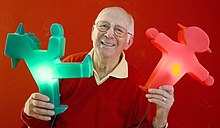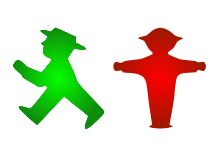Karl Peglau
Karl Peglau | |
|---|---|
 | |
| Born | 18 May 1927 |
| Died | 29 November 2009 (aged 82) Berlin, Germany |
| Occupation(s) | Traffic psychologist and engineer |
Karl Peglau (18 May 1927 – 29 November 2009) was a German
Peglau wanted to create a traffic light that would be both appealing to children, yet easily accessible and understandable for elderly Germans.[1] He deliberately designed the human figures, known as the Ampelmännchen, to be both creative and "cute".[1]
The
In 1997, the
Biography
Early life
Karl Peglau was born in the town of Muskau, Upper Lusatia in 1927.[3] He trained and studied in both engineering and psychology[4] at Humboldt University of Berlin.
Ampelmännchen in East Germany

By the early 1960s, traffic lights in the former
In the early 1960s, an
Peglau designed the glass human figures for the stop (red) and go (green) lights on the traffic signal in 1961, which became known as the Ampelmännchen.[4] Peglau deliberately designed the Ampelmännchen to be both friendly and approachable, which increased their popularity with East Germans.[4] The figures were created with easy-going stances, hats, "button noses" and "stocky builds".[4] Peglau described the Ampelmännchen's features as having the ability to project "an aura of coziness and human warmth".[4]
Peglau also designed the Ampelmännchen to be more effective and practical than the previous 1930s-era signals.[4] The green Ampelmännchen's stance resembled an arrow, while the red Ampelmännchen, with his outstretched arms,[3] looks similar to a barricade.[4] The large Ampelmännchen symbols made them easier to see in poor weather.[4]
Peglau's Ampelmännchen spread beyond East Berlin and became common throughout East Germany by the 1980s.
Reunification and later years
After

In 1996, Heckhausen won the
Peglau spent nearly 20 years following the
As of late 2009, Peglau's Ampelmännchen can still be found throughout secondary road and intersections within the former East Germany.[4] His symbols have also been adopted by some former West German cities as well.[4]
Karl Peglau died in Berlin, Germany, on 29 November 2009, at the age of 82.[3][4] He was survived by his wife, Hildegard, and their two children.
References
- ^ a b c d e "East German Loses Copyright Battle over Beloved Traffic Symbol". Deutsche Welle. 17 June 2006. Archived from the original on 6 March 2016. Retrieved 3 January 2010.
- ^ a b c d e f "Ampelmännchen is Still Going Places". Deutsche Welle. 16 June 2005. Archived from the original on 21 May 2009. Retrieved 3 January 2010.
- ^ a b c d e f "Karl Peglau, inventor of Berlin's famous Ampelmann, dies aged 82". Monsters and Critics. 1 December 2009. Archived from the original on 3 October 2012. Retrieved 3 January 2010.
- ^ German Missions in the United States. 1 December 2009. Archived from the originalon 6 March 2016. Retrieved 3 January 2010.
